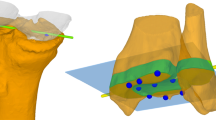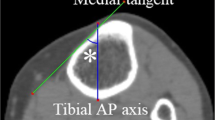Abstract
Background
Conventional intraoperative determination of lower limb alignment is essential for orthopedic surgical treatment. Current methods include the cable, alignment rod, and axis board methods.
Question/purposes
Are there differences in accuracy and reliability? What are the individual differences in applicability and radiation exposure?
Methods
Twenty legs from 12 fresh-frozen cadavers were randomly selected. After fixation of the legs, measurements were performed using the cable, alignment rod, and axis board methods. Afterwards, all cadavers were subjected to CT scanning. Intersection of the mechanical leg axis with the tibia plateau was calculated as the percentage of the tibia plateau, beginning at the medial border (0 %) and ending at the lateral border (100 %). Results are presented as mean ± standard deviation (SD).
Results
Compared with CT measurements, differences of the intersection at the tibia plateau were 3.9 ± 8.5 % with the cable method, 3.6 ± 7.6 % using the alignment rod, and 3.6 ± 9.6 % using the axis board. The difference among all measurements was not statistically significant (p = 0.450). The average intersection of the mechanical axis was 43.95 ± 5.15 % using the cable method, 43.93 ± 5.49 % using the alignment rod, and 43.77 ± 5.92 % using the axis board. CT measurements revealed an average intersection of 42.46 ± 5.22 %. There was no statistically significant difference among conventional results (p = 0.976). We demonstrated good intraobserver reliability for all three methods (cable method, ICC = 0.97; alignment rod, ICC = 0.95; and axis board, ICC = 0.96). There were no statistically significant differences regarding radiation time (p = 0.349) or dose area product (p = 0.823).
Conclusions
All described measurements demonstrated valid measurement of lower limb alignment. With minimal effort, all three methods present a practical and uncomplicated way to control the mechanical axis.




Similar content being viewed by others
References
Sharma L, Song J, Felson DT, Cahue S, Shamiyeh E, Dunlop DD. The role of knee alignment in disease progression and functional decline in knee osteoarthritis. JAMA. 2001;286(2):188–95.
Hsu RW, Himeno S, Coventry MB, Chao EY. Normal axial alignment of the lower extremity and load-bearing distribution at the knee. Clin Orthop Relat Res. 1990;255:215–27.
Papachristou G. Photoelastic study of the internal and contact stresses on the knee joint before and after osteotomy. Arch Orthop Trauma Surg. 2004;124(5):288–97.
Hernigou P, Medevielle D, Debeyre J, Goutallier D. Proximal tibial osteotomy for osteoarthritis with varus deformity. A ten to thirteen-year follow-up study. J Bone Joint Surg Am. 1987;69(3):332–54.
Matthews LS, Goldstein SA, Malvitz TA, Katz BP, Kaufer H. Proximal tibial osteotomy. Factors that influence the duration of satisfactory function. Clin Orthop Relat Res. 1988;229:193–200.
Paley D, Tetsworth K. Mechanical axis deviation of the lower limbs. Preoperative planning of uniapical angular deformities of the tibia or femur. Clin Orthop Relat Res. 1992;280:48–64.
Sprenger TR, Doerzbacher JF. Tibial osteotomy for the treatment of varus gonarthrosis. Survival and failure analysis to twenty-two years. J Bone Joint Surg Am. 2003;85-A(3):469–74.
Bathis H, Perlick L, Tingart M, Luring C, Zurakowski D, Grifka J. Alignment in total knee arthroplasty. A comparison of computer-assisted surgery with the conventional technique. J Bone Joint Surg (Br). 2004;86(5):682–7.
Jeffery RS, Morris RW, Denham RA. Coronal alignment after total knee replacement. J Bone Joint Surg (Br). 1991;73(5):709–14.
Lotke PA, Ecker ML. Influence of positioning of prosthesis in total knee replacement. J Bone Joint Surg Am. 1977;59(1):77–9.
Kettelkamp DB, Hillberry BM, Murrish DE, Heck DA. Degenerative arthritis of the knee secondary to fracture malunion. Clin Orthop Relat Res. 1988;234:159–69.
van der Schoot DK, Den Outer AJ, Bode PJ, Obermann WR, van Vugt AB. Degenerative changes at the knee and ankle related to malunion of tibial fractures. 15-year follow-up of 88 patients. J Bone Joint Surg (Br). 1996;78(5):722–5.
Krettek C, Miclau T, Grun O, Schandelmaier P, Tscherne H. Intraoperative control of axes, rotation and length in femoral and tibial fractures. Technical Note. Injury. 1998;29 Suppl 3:C29–39.
Liodakis E, Kenawey M, Liodaki E, Mommsen P, Krettek C, Hankemeier S. The axis-board: an alternative to the cable technique for intraoperative assessment of lower limb alignment. Technol Health Care. 2010;18(3):165–71.
Saleh M, Harriman P, Edwards DJ. A radiological method for producing precise limb alignment. J Bone Joint Surg (Br). 1991;73(3):515–6.
Hankemeier S, Hufner T, Wang G, Kendoff D, Zheng G, Richter M, et al. Navigated intraoperative analysis of lower limb alignment. Arch Orthop Trauma Surg. 2005;125(8):531–5.
Chao EY, Neluheni EV, Hsu RW, Paley D. Biomechanics of malalignment. Orthop Clin North Am. 1994;25(3):379–86.
Paley D, Herzenberg JE, Tetsworth K, McKie J, Bhave A. Deformity planning for frontal and sagittal plane corrective osteotomies. Orthop Clin North Am. 1994;25(3):425–65.
Portney LG, Watkins MP. Foundations of Clinical Research: Applications to Practice. 3rd ed. Upper Saddle River: Prentice Hall; 2008.
Mohanlal P, Jain S. Assessment and validation of CT scanogram to compare per-operative and post-operative mechanical axis after navigated total knee replacement. Int Orthop. 2009;33(2):437–9.
Gbejuade HO, White P, Hassaballa M, Porteous AJ, Robinson JR, Murray JR. Do long-leg supine CT scanograms correlate with weight-bearing full-length radiographs to measure lower limb coronal alignment? The Knee. 2013
Wang L, Fallavollita P, Brand A, Erat O, Weidert S, Thaller PH, et al. Intra-op measurement of the mechanical axis deviation: an evaluation study on 19 human cadaver legs. Med Image Comput Comput-Assist Interv : MICCAI Int Conf Med Image Comput Comput-Assist Interv. 2012;15(Pt 2):609–16.
Babazadeh S, Dowsey MM, Bingham RJ, Ek ET, Stoney JD, Choong PF. The long-leg radiograph is a reliable method of assessing alignment when compared to computer-assisted navigation and computer tomography. Knee. 2013;20(4):242–9.
Hankemeier S, Hufner T, Wang G, Kendoff D, Zeichen J, Zheng G, et al. Navigated open-wedge high tibial osteotomy: advantages and disadvantages compared to the conventional technique in a cadaver study. Knee Surg Sports Traumatol Arthrosc. 2006;14(10):917–21.
Acknowledgments
We would like to thank Dr. Paul Kretchmer (kretchmer@sfedit.net) at San Francisco Edit for his assistance in editing this manuscript and Wilko Ruether, MD, for assistance during measurements.
Author information
Authors and Affiliations
Corresponding author
Additional information
Each author certifies that he has no commercial associations (e.g., consultancies, stock ownership, equity interest, patent/licensing arrangements, etc) that might pose a conflict of interest in connection with the submitted article. The ethical committee of the Hannover Medical School approved the study (1952–2013).
Rights and permissions
About this article
Cite this article
Hawi, N., Liodakis, E., Suero, E.M. et al. A cadaver study comparing intraoperative methods to analyze lower limb alignment. Skeletal Radiol 43, 1577–1581 (2014). https://doi.org/10.1007/s00256-014-1972-9
Received:
Revised:
Accepted:
Published:
Issue Date:
DOI: https://doi.org/10.1007/s00256-014-1972-9




